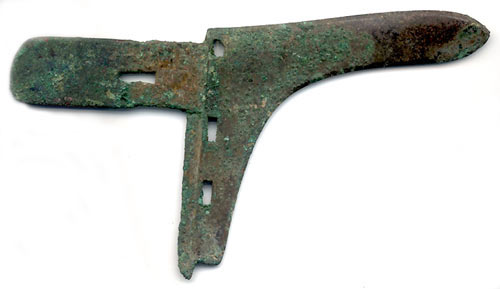

Larger image
775 x 448 - 44.3KB
China, Han Dynasty
ca 200 BC to 221 AD
BRONZE HALBERD BLADE (the Chinese name is a "GE"). 175 mm long, 95 mm high, 5.3 mm thick, 172.6 grams. This is a slightly smaller than average Halberd, but it was clearly well-sharpened in antiquity and it was certainly a functional fighting man's weapon (as opposed to a funerary or parade ground weapon).
The patination is a very dark brown with a considerable amount of green encrustations. There is a subdued almost silver tone to the areas of exposed metal, suggesting a high tin content in the bronze alloy. It has never been cleaned, and I suspect if one were to try and remove the encrustations there may be some rough metal from corrosion under the crust.
Blades like this were inserted through long poles, and securely tied on via the four holes one sees in the blade and tang, and used as long axes in battle. Sometimes two blades were attached (one above the other but almost touching) to the same pole, and often a spear point (called a MAO) was secured to the end of the pole above them. Normally there was also a bronze footer on the other end of the pole. They were probably very formidable weapons in the hands of a man trained to use one.
Order # antchina25 ...... $175.00
Copyright © 1997-2003 R & T Enterprises Ltd.